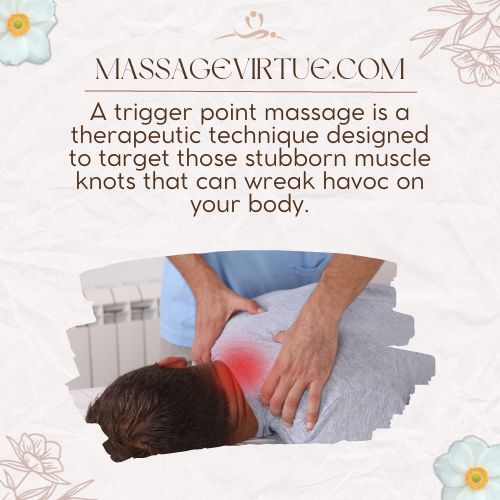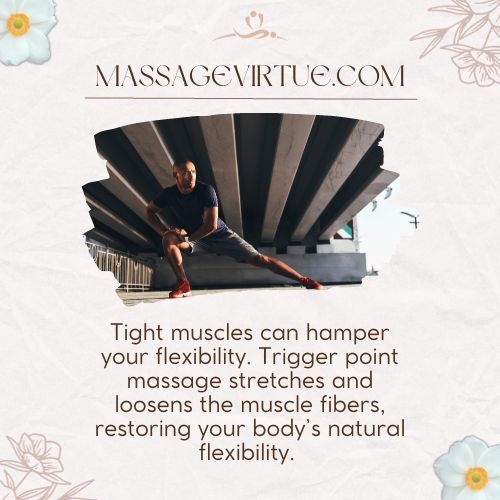In the world of wellness and pain relief, there’s a technique that’s been gaining attention for its remarkable benefits – trigger point massage.
If you’re battling stubborn muscle knots and stiffness, you’ve come to the right place.
In this article, we’ll dive into the fascinating world of trigger point massage, exploring what it is, the science behind it, and the incredible advantages it offers.
What is a Trigger Point Massage?
Let’s start with the basics. A trigger point massage is a therapeutic technique designed to target those stubborn muscle knots that can wreak havoc on your body.

These knots, known as trigger points, are tight bands of muscle fibers that form when muscles don’t release tension.
A skilled massage therapist uses precise pressure to release these knots, providing immense relief and promoting healing.
Trigger Point Massage Benefits
Now, let’s get to the heart of the matter – the benefits of trigger point massage. This technique offers a multitude of advantages for your physical and mental well-being. Here are seven key benefits:
1. Pain Relief
If you’re battling with persistent pain, trigger point massage is your ally. It effectively targets and releases trigger points, providing instant pain relief.
Whether it’s a sore back, tension headaches, or aching shoulders, this therapy can work wonders.
2. Improved Range of Motion
Stiffness and restricted movement often stem from trigger points.
By releasing these knots, you’ll notice a significant improvement in your range of motion. Say goodbye to feeling like the Tin Man from “The Wizard of Oz.”
3. Enhanced Flexibility
Tight muscles can hamper your flexibility. Trigger point massage stretches and loosens the muscle fibers, restoring your body’s natural flexibility.

You’ll be amazed at how much easier everyday movements become.
4. Reduced Muscle Tension
Muscle tension can be incredibly uncomfortable.
Trigger point massage helps relax those tense muscles, allowing you to feel more at ease and less like a coiled spring.
5. Stress Reduction
The physical release of tension during a trigger point massage also has a calming effect on your mind.
It’s like a double dose of relaxation, making it an excellent choice for those seeking stress relief.
6. Better Posture
Poor posture often results from imbalanced muscle tension. With regular trigger point massages, you can correct these imbalances, helping you stand tall and proud.
7. Faster Recovery
Athletes, listen up! Trigger point massage can expedite the recovery process after strenuous workouts or injuries.
It promotes blood circulation and accelerates the healing of damaged muscles.
8. Enhanced Circulation
Trigger point massage stimulates blood flow to the treated areas.
This increased circulation not only promotes the delivery of vital nutrients to your muscles but also aids in the removal of waste products.
As a result, your muscles function more efficiently, and you feel rejuvenated.
9. Improved Sleep Quality
If you’ve ever struggled with sleep disturbances due to pain or discomfort, trigger point massage can be a game-changer.

By easing muscle tension and reducing pain, it paves the way for a more restful and uninterrupted night’s sleep, leaving you feeling refreshed in the morning.
10. Holistic Well-Being
Beyond physical benefits, trigger point massage contributes to your overall holistic well-being.
It encourages a mind-body connection, helping you become more aware of your body’s signals and needs.
This heightened awareness can lead to better self-care practices, fostering a sense of balance and harmony in your life.
Trigger Point Massage Techniques
Wondering how those magic hands work their wonders? Here are some of the techniques used in trigger point massage:
- Static Pressure: The therapist applies steady pressure to the trigger point until it is released.
- Stretching: Gentle stretching of the muscle can help release tension.
- Deep Strokes: Firm, gliding strokes are used to access and treat deep-seated trigger points.
- Compression: Pressure is applied to the trigger point using fingers, thumbs, or even elbows.
- Ischemic Compression: Pressure is applied until blood flow is temporarily reduced to the trigger point, which can help it release.
Disadvantages of Trigger Point Therapy
While trigger point massage offers numerous benefits, it’s essential to be aware of its limitations. Let’s have a look at some of the disadvantages:
| Disadvantage | Description |
| Temporary Discomfort | During the massage, you may experience some discomfort as trigger points are being released. |
| Multiple Sessions | Achieving lasting relief may require several sessions, depending on the severity of your condition. |
| Soreness Afterward | It’s common to feel sore after a trigger point massage, but this usually subsides within a day or two. |
| Cost | Professional trigger point massages can be relatively expensive, especially with multiple sessions. |
| Not Suitable for All | It may not be suitable for individuals with certain medical conditions, so consult your healthcare provider. |
| Skill-Dependent | The effectiveness of the massage depends on the skill and experience of the therapist. |
Conclusion
In conclusion, trigger point massage is a powerful tool for anyone seeking relief from muscle pain, improved mobility, and enhanced well-being.
By addressing the root causes of discomfort, it offers a holistic approach to wellness.
However, it’s crucial to understand that while it has its advantages, it may not be suitable for everyone and may require patience for the best results.
FAQs
What Does Trigger Point Massage Do?
Trigger point massage addresses muscle knots, known as trigger points, by applying pressure to these tight areas.
This therapeutic technique brings pain relief, improved range of motion, reduced stress, enhanced circulation, better posture, and injury prevention, and complements other therapies.
How Often Should You Massage Trigger Points?
The frequency varies, but it can be as needed for acute issues, regularly for chronic tension (e.g., once a week or bi-weekly), or as recommended by a therapist or healthcare provider.
Is It Good to Release Trigger Points?
Yes, releasing trigger points through massage is generally beneficial. It alleviates pain, improves mobility, and enhances overall well-being.
However, it should be done with care under the guidance of a skilled therapist.
What Should I Expect After a Trigger Point Massage?
After a session, expect immediate relief, potential soreness (like post-workout soreness), improved mobility, relaxation, and the need to stay hydrated to flush out released toxins.
Individual responses may vary, so consult your therapist or healthcare provider for concerns or unusual discomfort.


